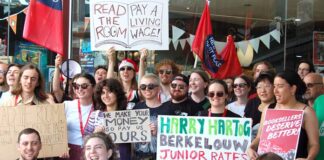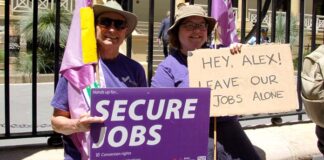In 1969 over one million workers took part in a general stoppage and won the freedom of jailed union official Clarrie O’Shea and an end to the penal powers. With the ABCC and most of the WorkChoices laws intact, Amy Thomas looks at the lessons for today.
On his way to court on 15 May, 1969, Tramways Union official Clarrie O’Shea led a march of five thousand workers.
They were mostly union delegates from a meeting at Melbourne Trades Hall, called by left wing union leaders who had recently split from the other conservative unions in Victoria. The 27 unions had met to discuss and vote on a course of action to fight the penal powers and the recent court action against the Tramways Union.
During the wages struggles of the 1960s, the Conciliation and Arbitration Commission sought to restrict union activity by placing “bans clauses” into awards that made strike action illegal. The penal powers had been used heavily since Liberal Prime Minister Menzies introduced them in 1956.
The Commission used the laws to discipline unions and to make industrial action a criminal and costly exercise.
Over 13 years, unions were fined 799 times, at a total cost of $282,410. By contrast, bosses were fined just $2978 over 25 years. Once you add legal costs, unions were robbed $1 million of members’ money.
For its work over five years in militantly defending the rights of its members, the Tramways Union alone had accumulated 40 fines, totalling $15,619, most of which was accumulated for leading workers in a 14-week bus strike in 1966. While the Tramways leaders had agreed to pay a tokenistic amount of $100 per month, they consistently made clear a strategy of defying the penal powers.
Their stance wasn’t to the liking of the courts and the bosses, who were worried about the success of the metalworkers’ 1968 wage claim and the threat of more to come. The government moved to confiscate the union’s funds in 1969, and seized the bank account of the Victorian branch.
O’Shea was called to court to produce the union’s books. After ignoring several notices to appear, O’Shea took to the stand after leading the rally on 15 May and refused to take an oath, or to reveal the location of the unions remaining funds.
He stated: “Because I am a paid servant of my members, I am directed to protect their interests at all times, whether it is in regard to their wages, working conditions or their funds.” John Kerr, later to become the Governor General who sacked Whitlam, immediately jailed O’Shea for contempt of the Industrial Court.
The arrogant overconfidence of the bosses, built up over several years of union bashing, was about to take a battering.
A wave of action
As soon as the news reached the rally outside, a mood of anger and defiance spread quickly. There were immediate walkouts in Victoria, followed by two 24-hour stoppages involving 40 unions. Trains and trams stopped, delivery of goods was restricted, the power went out and TV and radio broadcasts were disrupted.
The Trades and Labour Council of WA, the Queensland Trades and Labor Council and the United Trades and Labour Council of South Australia all called statewide general strikes. In Queensland, mass meetings or strikes occurred in 20 cities and towns. Newcastle, Wollongong and Canberra had members of affiliated unions on the streets.
In Tasmania, where the Trades and Labour Council refused to sanction any action, “rebel” unions representing 50,000 workers—or 80 per cent of Tasmania’s workforce—organised a general stoppage.
The conservative union leaders, including those at the Australian Council of Trade Unions (ACTU), where forced by rank-and-file demands to support the actions, despite a previous unwillingness to take on the penal powers.
Even when their union wasn’t officially supporting the strike, workers’ themselves took action. The secretary of the Geelong Trades Hall Council, Bernie O’Leary, reported: “Although some unions were not officially involved, in some cases large numbers of their members knocked off and were present at our meetings.” Australian Workers Union members struck at the Stuart copper refinery and in Pilbara and Kalgoorlie against the instructions of conservative officials.
The strength of the strike wave surprised many. John Arrowsmith, a historian of the strike and then member of the Communist Party, has said:
“I think it surprised everyone. But the reaction to the announcement that O’Shea had been jailed was absolutely electric. Everybody thought that this was something they had to get into. Every union official was swamped by calls—people wanted to know what the unions were going to do.”
A combination of factors drew workers onto the streets. There was a rising tide of anger among workers who had suffered under 13 years of the penal powers and were not getting their share of the 60s economic boom. The campaign against the Vietnam War and the growing radicalisation among students and youth at the time was also beginning to spread to the workplace.
The Tramways Union, along with other left-led unions, had also made clear their intention to escalate industrial action to defeat the powers before O’Shea’s jailing.
The leadership to the left of the ALP, predominantly from the Communist Party and its splinter groups (O’Shea himself was a member of the China-aligned, Communist Party Marxist-Leninist) was crucial to leading rank-and-file resistance and building confidence to fight the laws.
Arrowsmith said of this: “We spent years organising. We fought against the idea of the ‘menace from the north’, we fought against attacks on democratic rights; we worked most effectively among youth; we resisted the attacks on the unions… It was undoubtedly the vision of a handful of Communists in Victoria that was the core of it all.”
As well as a general expression of working class anger and frustration, the O’Shea strike was the culmination of this defiant vision.
The powerful display of workers’ confidence and control shook up the ruling class. Six days after his jailing, O’Shea’s fines were paid by a former newspaper editor, widely believed to be acting for the government.
O’Shea was released to a mood of mass celebration. The penal powers, while they weren’t repealed, became a dead letter.
Refusal
The ACTU soon had an official policy of refusal to pay any fines, and the ALP national conference of 1970 passed a motion opposing the powers.
Employers were requested to refrain from using them, so frightened was the government at the possibility of another backlash!
The victory also paved the way for further struggles. Renewed working class confidence saw rages rise by 20 per cent in the early 1970s. Jack Mundey, leader of the Builders’ Labourers Federation ‘green bans’ struggle in the 70s, attributes some of his union’s confidence to the victory of the O’Shea dispute.
It was the gains of that period that the Howard government set out to erode with the introduction of both WorkChoices and the Australian Building and Construction Commission. It was the “right to strike” particularly—the most fundamental and effective display of workers’ collective power—that Howard sought to remove from workers’ arsenal.
While the unpopularity of such anti-worker policies was surely what cost the Howard government the election and swept Rudd to power a year ago, we are still struggling against WorkChoices-lite and at least another year of the ABCC.
The new industrial relations legislation (covered elsewhere in this edition of Solidarity) changes some basic conditions but keeps very similar restrictions on industrial action. It is a victory and a testament to Labor’s awareness of WorkChoices’ unpopularity—but the continued restrictions on the right to take action are the result of the fact the union Rights at Work campaign didn’t take the fight for those rights seriously or far enough.
The campaign against the ABCC is a chance to take up the fights for those rights. The specific targeting of the more militant construction unions is no coincidence—it is because they pose the most threat to efforts to hold down wages and conditions.
There is much to learn from O’Shea’s, and now Washington’s, refusals. In both cases, their defiance, and the widespread support for it, was too much for the ruling class to take.
If we want to make the injustice of the ABCC the next dead letter law, the “rights on site” campaign needs to adopt an official policy of defiance of the Commission and of the remaining restrictions on industrial action. As the economic crisis unfolds, the struggle over who pays for the bosses’ mess is set to begin—and we need a fighting union movement to make sure it isn’t us.





